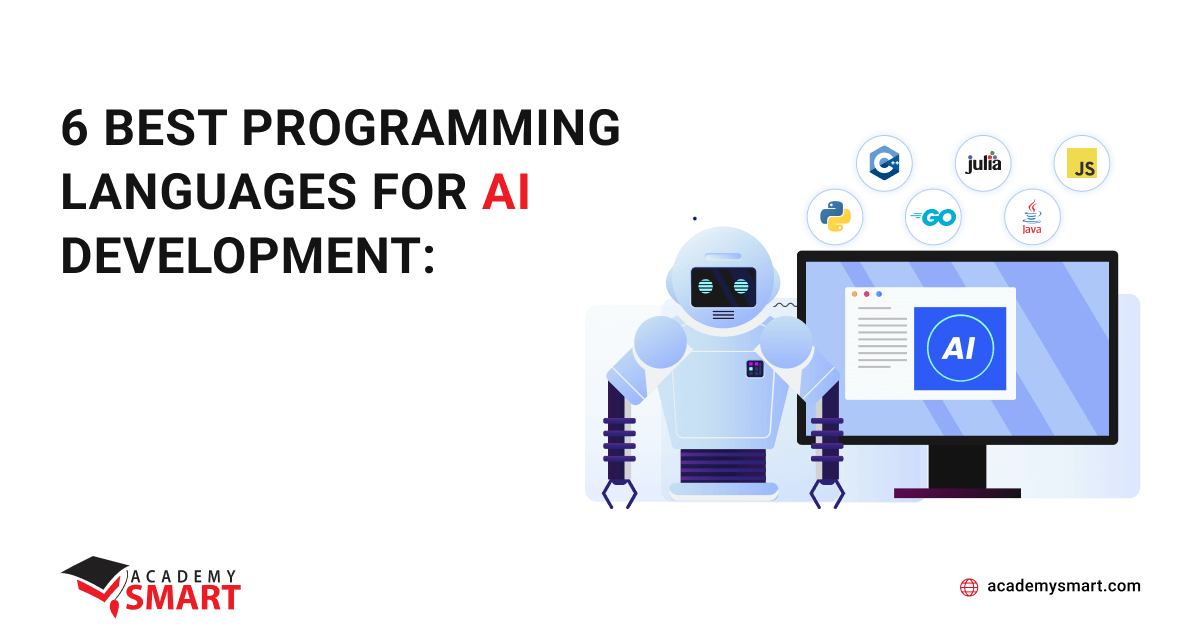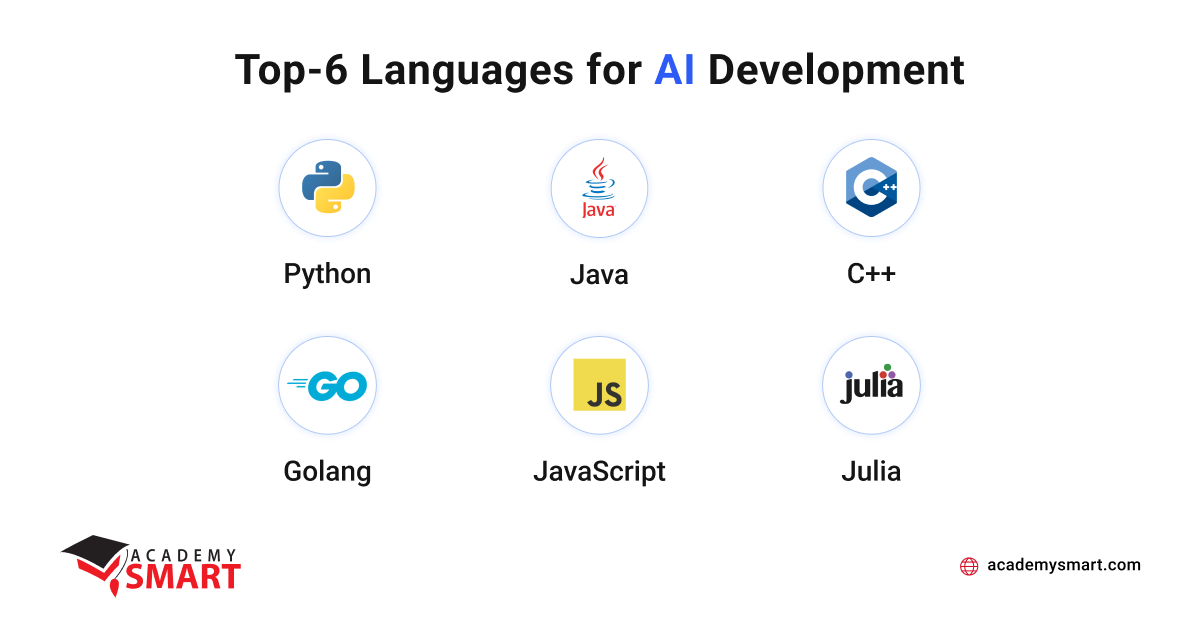
6 Best programming languages for AI development
Contents
The world of information technology is rapidly changing. Whereas before, the scope of AI was limited mainly to scientific research and defense, today, for many applications, having a suitable AI solution may become the only way to ensure their competitive advantage and place in the market. In other words, implementing artificial intelligence systems in the next decade is a given and a big challenge for existing enterprises.
Of course, it is crucial to use the full power of artificial intelligence in the interests of your business on time. However, it is equally important to have specialists competent in this field at your disposal who can create practical and reliable AI models.
So, it’s time to explore the most popular programming languages for AI development to understand the skills developers must demonstrate when hiring. And make sure to check out our portfolio, where you can see examples of applications our team developed based on AI and ML technologies.

Projects Academy Smart has delivered
TOP-6 best programming languages for AI
Artificial intelligence is a branch of computer science and engineering that focuses on creating intelligent machines that can perform tasks that typically require human intelligence, such as learning, problem solving, perception, and decision-making. The concept of AI has been around for centuries, but the actual development of AI as a scientific field began in the mid-20th century.
Fortran was the first programming language for AI development, but the LISP and Prolog contributed the most significantly.
LISP, “LISt Processing,” was developed in the late 1950s and became a popular language for AI research in the 1960s and 1970s. LISP’s primary data structure is the linked list, which is well-suited for AI tasks such as natural language processing and symbolic reasoning. LISP is also known for its support for functional programming, which emphasizes using mathematical functions to transform data.
Prolog, which stands for “PROgramming in LOGic,” was developed in the 1970s and is based on first-order logic. Prolog’s syntax and semantics are designed to enable the declarative representation and manipulation of knowledge. Prolog has been used for expert systems, natural language understanding, and automated theorem proving.
LISP and Prolog continue to be used in AI research and development today. However, more modern languages, such as Python and Java, have given their dominant popularity to AI apps in recent years.
What branches of AI technology may be helpful for your business applications?
- Machine Learning
The study of algorithms and statistical models that allow computer systems to automatically improve their performance on a specific task with data without being explicitly programmed. - Natural Language Processing
The ability of machines to understand, interpret, and generate human language, both in written and spoken form. - Computer Vision
The field of study that enables machines to interpret and understand visual data from the world, such as images and videos. - Robotics
The design, construction, operation, and use of robots, as well as computer systems for their control, sensory feedback, and information processing. - Expert Systems
Computer programs designed to mimic a human expert’s decision-making abilities in a particular field, such as medical diagnosis or financial analysis. - Neural Networks
A set of algorithms modeled after the human brain that allow computers to recognize patterns and make decisions based on input data. - Cognitive Computing
A field that aims to create computer systems that can simulate human thought processes and solve problems in a human-like way. - Autonomous Systems
Computer systems that are capable of performing tasks without human intervention, such as self-driving cars or drones.
They often overlap and draw from each other to create more advanced AI systems and perform many functions, improving operations, reducing costs, and increasing revenue.
AI technology can be beneficial in many ways. Here are a few examples:
- Predictive Analytics
AI analyzes data and predicts future trends, such as customer behavior, market trends, and sales forecasting. It can help businesses make informed decisions and take proactive measures. - Customer Service
AI can be used to develop chatbots, virtual assistants, and voice recognition systems that can provide 24/7 customer support. It reduces their support costs while improving customer satisfaction. - Marketing
AI can analyze customer data and behavior to develop personalized marketing campaigns. That can help enterprises target their marketing efforts more effectively and improve their ROI. - Fraud Detection
AI can detect fraudulent activities and transactions. It reduces their financial losses due to fraud and protects their reputation. - Supply Chain Management
AI can be used to optimize supply chain management processes, such as inventory management, demand forecasting, and logistics planning. It helps companies reduce costs and improve efficiency.
To create a perfect AI application, you must systematically combine knowledge of algorithms, programming languages, and domain-specific expertise to solve complex problems. For AI design, developers often require additional software tools, among which R and Matlab stand out. They have a wide range of built-in functions and libraries for statistics, linear algebra, optimization, and other mathematical operations that are commonly used in AI development.
Unsurprisingly, the demand for talented AI programmers constantly grows, and finding them independently in practice isn’t easy. In the article on recruiting IT professionals, you will find valuable tips on making this task easier for yourself. And now, let’s look at the best programming languages in the field of AI today.
1. Python
Python is AI developers’ most prevalent programming language due to its syntactic simplicity and versatility. It is widely used because it is less complex than C++ and Java and supports object-oriented, procedural, and functional programming styles. Python is a portable language used on various platforms such as Linux, Windows, Mac OS, and UNIX.
Python’s features, such as interactivity, interpretability, modularity, and dynamic, portable, and high-level programming, make it unique. Python supports the development of neural networks and NLP solutions with its simple function library and more user-friendly structure. Additionally, it supports the testing of algorithms without needing to apply them.
Python programs are slower than C++ or Java examples because of an interpreter with slower compilation and execution, but they take much less time to develop. Its programs are typically 3-5 times shorter than equivalent Java or C++ programs, thanks to Python’s built-in high-level data types and dynamic typing. Python’s powerful polymorphic list and dictionary type, for which rich syntactic support is built into the language, finds use in almost every Python program.
Python is a highly efficient programming language used for developing AI applications, offering several advantages over other programming languages. One of the most significant benefits is its simple syntax, making it easier to test and focus on programming itself. Additionally, Python is equipped with built-in libraries, providing a streamlined approach to development. That allows developers to focus on building AI applications rather than worrying about the underlying structure.
Python offers a variety of handy tools that make this language the best choice for AI programming:
- NumPy library facilitates working with multidimensional arrays and provides fundamental linear algebra functions. The SciPy library builds on NumPy by adding necessary primitives, numeric optimizers, and signal processing capabilities for statistics and restricted linear algebra. It is used in almost half of all machine-learning projects. Pandas is another library that enables the representation of tabular data in Python and supports data extraction, transformation, context loading, and analysis.
- TensorFlow is an open-source framework developed by Google to simplify the implementation of machine learning and deep learning models. It offers a variety of libraries and algorithms that enable developers to train and run deep neural networks for tasks such as image recognition, natural language processing, and sequence modeling. One of the strengths of TensorFlow is its ability to efficiently evaluate complex mathematical expressions using multidimensional arrays called tensors, which is essential for training deep neural networks. Additionally, TensorFlow includes powerful tools for optimizing memory usage and data processing. It also supports GPU computing, which can significantly speed up training times for large datasets.
- The Natural Language Toolkit (NLTK) is a software framework that enables Python programs to work with human language data. It offers user-friendly interfaces, a set of linguistic resources like WordNet, and a text-editing library package that performs classification, tokenization, stemming, tagging, parsing, and semantic reasoning. NLTK caters to many users, such as linguists, engineers, students, educators, researchers, and enterprises.
- Theano is a Python library that optimizes the processing of mathematical expressions containing multidimensional arrays. The library has efficient character differentiation, dynamic C code generation, and unique testing and self-validation features to ensure stability and speed. It works seamlessly with NumPy and can transparently use the GPU for faster performance.
- Scikit-learn is a powerful Python module that offers various machine-learning algorithms designed to handle medium-sized supervised and unsupervised problems easily. Its primary focus is providing a seamless user experience, ensuring high performance, and delivering a complete and consistent API. Scikit-learn is available under the BSD license, making it suitable for use in both academic and commercial environments.
- Keras is a Python-based API for deep learning that operates on top of the TensorFlow ML-framework. Its primary focus is modern deep learning, providing an efficient, high-performance interface for solving machine learning problems. Keras supplies the fundamental abstractions and building blocks for developing high-iteration machine learning solutions. It can run on TPUs or large GPU clusters, and Keras models can operate on mobile devices or within web browsers.
Thus, due to its simple syntax and compact code, Python is one of the best programming languages for developing AI applications which offers several advantages, including:
- Support for functional and structural programming methods and object-oriented programming (OOP).
- High-level dynamic data types providing.
- Scripting and compiled into bytecode for larger applications.
- Easy integration with other programming languages and frameworks such as C++, Java, ActiveX, COM, and CORBA.
2. Java
Java is a multi-paradigm programming language that adheres to object-oriented designing and the “Written Once, Run Anywhere” principle, making it an ideal language for developing artificial intelligence applications. It can run on any platform without the need for recompilation. Java is particularly suited for NLP and search algorithms and can run neural networks. While Java’s syntax is similar to C and C++, it is easier to use and includes an automatic memory manager to simplify the work of developers. Even if Java programs are slower than C++, they have significantly more performance than Python.
Java offers several built-in tools and libraries that make it suitable for AI programming, including:
- OpenNLP is a natural language processing library in Java that supports several NLP tasks, such as named entity recognition, sentence segmentation, and part-of-speech tagging.
- Weka is a popular ML library that supports several data mining tasks such as clustering, classification, regression, and feature selection.
- Deeplearning4j is a powerful deep learning library supporting many neural network architectures, including convolutional neural networks, recurrent neural networks, and deep belief networks.
- Apache Mahout is a scalable machine-learning library in Java that supports several popular ML algorithms, such as k-means clustering, collaborative filtering, and singular value decomposition.
- DL4J is an open-source deep learning library with a wide range of neural network architectures and algorithms, including convolutional neural networks, recurrent neural networks, and deep belief networks.
- JavaML is a collection of ML algorithms that supports clustering, classification, regression, and feature selection.
So, platform independence, high efficiency, and the large community of Java engineers make this language one of the most popular and in demand in AI application programming.
3. C++
C++ is a high-performance programming language that prioritizes speed, making it an excellent choice for developers who value efficiency. Fast execution and quick loading time suits applications such as search engines and computer games well. With C++, developers can leverage various algorithms and statistical methods for artificial intelligence. The language also supports program reuse through inheritance and data hiding, significantly saving time and cost.
C++ is a multi-paradigm program that supports object-oriented principles, which help organize data. Its rich library functions and software tools make it highly versatile. C++ is particularly well-suited for machine learning and neural networks, making it an ideal tool for tackling complex AI problems.
However, C++ has limitations when it comes to multitasking, and it is only suitable for using the kernel or database of specific systems or algorithms. The bottom-up approach can be complex, which may make it difficult for novice developers to write AI programs.
What are the tools that make this programming language used for building highly performant AI models?
- Standard Template Library (STL) provides a set of reusable data structures and algorithms to develop efficient AI programs.
- Boost C++ Libraries is a collection of libraries that extend the functionality of C++, including libraries for math, data structures, linear algebra, and more, which can be helpful in AI programming.
- OpenCV is a library of computer vision algorithms used in AI applications such as image recognition, object detection, and tracking.
- Tensorflow is a popular machine learning framework, and its C++ API exists to create AI programs that are optimized for performance.
- Dlib is a library of machine learning algorithms, including deep learning algorithms for various AI applications.
- Intel Math Kernel Library (MKL) is a library of mathematical functions optimized for Intel processors, perfect for developing high-performance AI applications.
4. Julia
Julia is a young, high-level dynamic programming language that was specifically designed to address the needs of high-performance numerical and scientific computing, making it an excellent choice for AI creation. Julia is fast and efficient, thanks to its just-in-time (JIT) compilation and multiple dispatches, which allow it to compile code on-the-fly for specific data types and optimize it for performance.
It is designed to work well with existing code and libraries, easily integrated with different languages and tools. It has a simple syntax and is easy to learn for those familiar with other programming languages like Python or MATLAB. It is flexible and can be extended to support new features and applications as needed. But as a new programming language, it has a relatively tiny community of qualified developers.
Julia has built-in support for parallel computing, making it easy to use multicore CPUs, clusters, and GPUs to speed up computation. It also supports distributed computing, making it possible to scale up computations across multiple machines.
With the following tools, Julia has rightfully considered one of the most used common programming languages for building AI applications:
- MLJ.jl is a machine-learning library that provides a unified interface to various ML algorithms and tools. It supports supervised and unsupervised learning, cross-validation, hyperparameter tuning, model selection, and feature selection. MLJ.jl also has built-in support for distributed and parallel computing.
- Flux.jl is a deep learning library that provides a fast and flexible platform for developing and training deep neural networks. It includes a comprehensive set of tools for building and training neural networks, including layers, activations, loss functions, and optimizers. Flux.jl also has built-in support for GPU acceleration and automatic differentiation.
- Turing.jl is an addon of probabilistic programming language that provides a flexible and efficient platform for building and fitting Bayesian models. It includes a comprehensive set of tools for modeling complex data, including distributions, random variables, and probabilistic programs. Turing.jl also has built-in support for sampling and inference.
- Metalhead.jl is a computer vision library for Julia that provides a set of pre-trained deep-learning models for image classification and object detection. It includes models based on state-of-the-art architectures, such as ResNet and MobileNet, and supports fine-tuning and transfer learning. Metalhead.jl also has built-in support for data augmentation and image preprocessing.
5. JavaScript
JavaScript is a popular language used for developing web applications, but it also has the potential for AI programming. JavaScript is a universal language, and with the help of Node.js, it is usually used for server-side programming. That opens up possibilities for building scalable and distributed AI systems.
JavaScript also has the advantage of being a widely used language, which we covered in the article “TOP-10 The Most Popular Programming Languages 2023” in detail. It means a large community of developers that can share knowledge, collaborate and contribute to the development of AI tools and applications.
Furthermore, JavaScript can be used to create interactive data visualizations and user interfaces, which can help present and interact with AI-generated outputs. It could be particularly beneficial for applications that involve natural language processing, sentiment analysis, and image recognition.
Additionally, several libraries and frameworks are available for machine learning in JavaScript:
- TensorFlow.js allows developers to use TensorFlow, a popular machine learning library, in JavaScript. It provides APIs for training and running models in the browser or at Node.js infrastructure.
- Brain.js is a flexible and easy-to-use neural network library that works in the browser or on Node.js. It provides a simple API for creating and training neural networks.
- Synaptic.js is a lightweight and efficient neural network library for JavaScript. It provides a simple API for creating and training neural networks.
- ConvNetJS provides a simple API for building and training convolutional neural networks in the browser.
- Natural Node is a JavaScript port to Python’s library Natural Language Toolkit. It provides a range of tools and resources for working with text data.
6. Golang
Go, also known as Golang, is another modern programming language that is designed to provide a balance between simplicity and performance. Although it wasn’t originally created for AI development, it has some features that make it a good choice for building machine learning models and other AI applications.
One of the key strengths of Go is its excellent support for concurrent programming. It lets developers write highly concurrent and parallel programs quickly. That makes it well-suited for developing large-scale ML applications that require processing large amounts of data in parallel.
Another advantage of Go is its speed. Go is a compiled language that produces highly optimized binaries faster than interpreted languages like Python. That makes it ideal for developing high-performance AI applications, such as real-time image and speech recognition systems.
The Go standard library includes packages for working with data formats like CSV, JSON, and XML, making working with data from various sources easy. Finally, Go strongly focuses on code readability and maintainability, making it easy for teams to collaborate on AI projects. Simple syntax and a straightforward approach to programming can reduce errors and make code easier to understand and maintain over time.
Golang has a growing number of AI-related libraries, including packages for machine learning (GoLearn), natural language processing (GoNLP), and computer vision (GoCV):
- A TensorFlow library is available for Go that allows developers to build and deploy machine learning models.
- Gorgonia is a library for deep learning in Go. It provides a set of composable building blocks for defining and training machine learning models.
- Fuego is a library that provides support for fuzzy logic in Go. Fuzzy logic is a technique used in AI that allows for reasoning with uncertain or imprecise data.
- GoML is a library that provides a set of machine-learning algorithms that can be used for classification, regression, and clustering.
- Gobot is a library for robotics and IoT development in Go. It supports various hardware platforms, such as Raspberry Pi and Arduino, and can be used for developing AI applications that interact with the physical world.

The most commonly used programming languages for AI today
How Academy SMART can help you
Our custom software development practice has been tasked several times to build AI and machine learning applications in manufacturing, healthcare, fintech, and e-learning areas. With this invaluable experience, we are well aware of the advantages of equipping modern software products with an effective data processing system using artificial intelligence and what benefits this gives the application in the fierce competition in the market today.
As a reliable outsourced software development service provider, we offer a qualified team of AI application developers and a responsible project manager who will guide you from an idea to a ready-to-release product, and a competitive offshore price in Ukraine.
You may also be interested in our offer to expand your workforce with experienced programmers in developing AI and ML systems as outstaffers. In the shortest possible time, we are ready to communicate with you strong specialists in Python, Java, Go, and JavaScript who will significantly strengthen your internal team’s capabilities
Is it time to use the power of artificial intelligence in your enterprise? We are confident to be of service, so let’s discuss your business challenges.
Programming languages for AI: Frequently Asked Questions
Is AI coded in Python?
Python is the most popular programming language for artificial intelligence and machine learning today, but it is not the only one. Other programming languages such as Java, C++, Julia, and Golang are also used for AI programming.
Can you make AI with C++?
C++ is a high-performance programming language suitable for developing complex AI algorithms and applications. But creating AI models with C++ requires more low-level programming and time to code than languages like Python.
Book a free consultation

Reach out to start talking today!











